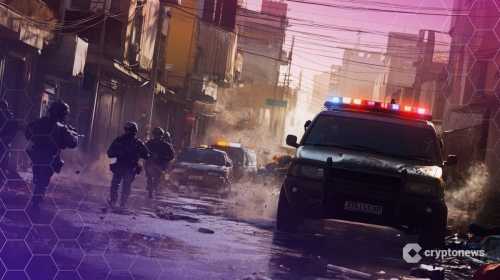Tokenized RWAs Expected to Disrupt TradFi by 2025

Tokenization of RWAs (real-world assets) is becoming an important goal across major markets globally. In particular, this is being driven by the traditional financial (TradFi) sector.
Research from Ernst & Young found that 50% of institutional investors have expressed specific interest in investing in tokenized assets.
RWA tokenization refers to financial products and tangible assets minted on a blockchain network, allowing for increasing investor accessibility and better trading opportunities.
The RWA market has expanded by 80% over the past two years and is expected to see strong growth moving forward.
According to Standard Chartered, tokenized RWAs could reach $30.1 trillion by 2034. Most recently, the total RWA market recorded a new all-time high of $17.4 billion.
🚨 Breaking: TOTAL RWA VALUE HITS A NEW ATH OF $17.4B!
While the market struggles, #RWA continues to dominate 🔥#RWA tokens will leading the bull run! 🚀 pic.twitter.com/A8Of4xUN7B
— Real World Asset Watchlist (@RWAwatchlist_) February 19, 2025
Tokenized RWAs Will Flourish in 2025
Given the demand for tokenized RWAs, 2025 is predicted to be monumental for the sector’s growth.
Bhaji Illuminati, CMO of RWA tokenization platform Centrifuge, told Cryptonews that the crypto industry is currently witnessing a perfect alignment of forces that have been building for years.
“Regulatory clarity within US major financial institutions are now moving beyond proof-of-concept to actual implementation plans,” Illuminati said.
Illuminati added that critical infrastructure like custodians and exchanges now support tokenized assets.
For example, Elon Musk, the head of the Department of Government Efficiency (DOGE), is reportedly exploring implementations of blockchain technology in US government operations to track and reduce federal spending.
You might also like Elon Musk Eyes Blockchain as Tool to Overhaul Govt Spending Oversight: Report
The DOGE is also looking at using blockchain to secure data, make payments, and manage buildings as part of the organization’s efficiency push.
“Every major sector is developing a tokenization strategy,” Illuminati remarked. “What makes 2025 different is that we have genuine demand from both sides of the market – traditional finance wants better infrastructure, while crypto markets need reliable, stable yields.”
TradFi Shows Increasing Interest in Tokenized RWAs
As a result of this innovation, industry experts believe that institutional players will deepen their involvement in the RWA space.
Erin Chen, CEO of Injective Labs, told Cryptonews that RWAs will undoubtedly play a role in bridging traditional finance with decentralized finance (DeFi), making 2025 a defining moment for mainstream adoption.
“Real-world assets will have the biggest impact on traditional finance this year,” Chen said. “Tokenizing assets like bonds and equities will enhance market efficiency, improve liquidity, and streamline settlement. This will make markets more accessible, while reducing counterparty risk.”
TradFi and Tokenized RWA Use Cases
While the concept is still relatively new, tokenized RWA and TradFi use cases are quickly emerging.
For example, Taurus – a digital asset infrastructure firm backed by Deutsche Bank – recently launched an enterprise-grade custody and tokenization platform.
🤝 @taurus_hq integrates with @solana to provide institutions with secure custody, staking, and scalable issuance of tokenized assets on the popular blockchain.#Solana #Taurus #Tokenizationhttps://t.co/rrt9VcxWL0
— Cryptonews.com (@cryptonews) February 13, 2025
Known as “Taurus-Capital,” the platform is built on the Solana blockchain to serve global financial institutions seeking to build tokenized asset solutions.
The integration will allow banks and issuers to securely custody and stake any Solana-native tokenized assets via the firm’s custody platform, Taurus-PROTECT.
Jürgen Hofbauer, head of global strategic partnerships at Taurus, believes that this integration will enable Taurus’ banking and enterprise clients to access a number of tokenized assets, like bonds and equities, while minimizing costs and operational complexities.
Richard Gendal Brown, founding chief technology officer at R3, told Cryptonews that the firm’s tokenization platform, Corda, has live, in-production solutions for regulated financial markets.
He mentioned that Corda is trusted by the world’s largest banks and financial market infrastructures.
According to Gendal Brown, R3’s Corda was used as the basis for the United Kingdom’s Regulated Liability Network’s (UK RLN) experimentation phase.
“This project brought together eleven of the country’s largest banking and payments providers, leveraging Corda to connect diverse forms of money on a single network, including tokenized central and commercial bank deposits,” he said.
Gendal Brown noted that the final results of the project were published last September. Findings demonstrate a comprehensive API for the tokenization platform to interact with all forms of money.
“Crucially, this demonstrated that an RLN could deliver significant benefits in real-world applications, including potentially reducing payment fraud and streamlining complex transactions, such as property purchases,” he commented. “Industry collaborations like this are shaping future digital economies by providing a roadmap for implementing asset tokenization to streamline legacy processes and operations.”
Advancements Around Tokenized RWAs
While it’s clear that traditional financial institutions have begun leveraging tokenization, advancements are being made to drive adoption.
Sebastiaan Opschoor, CMO at tokenization hub RWA.io, told Cryptonews that the RWA tokenization space remains highly fragmented.
“Hundreds of projects exist, but they struggle to connect with investors, find the right infrastructure, and navigate the ecosystem,” Opschoor said.
He explained that RWA.io solves this by bringing everything together in one place, making tokenized assets available to anyone, globally.
RWA.io enables this by allowing projects to create a public profile, find liquidity, connect with investors, and access infrastructure.
“As projects grow, organizations can integrate with blockchains, index funds, and more, making their tokens easily investable. Essentially, RWA.io bridges the gap between projects and investors, ensuring everyone has what they need to succeed,” Opschoor said.
In addition, Gendal Brown explained that R3 Digital Markets is a product suite leveraging Corda to enable RWA tokenization for real-world benefits.
“It was developed to help financial institutions and corporations accelerate their digitalization journey towards production, lowering costs and widening market access,” he said.
For instance, the “R3 Digital Lab” enables organizations to track digital solution development. This lets projects skip the proof-of-concept phase and move directly to production-ready validation.
The “R3 Digital Currency” supports central banks and financial institutions looking to integrate digital currencies and their benefits into client offerings.
Challenges May Slow Adoption, But Hopes Remain High
Although advancements are being made, Opschoor pointed out that tokenized RWAs will not transform TradFi immediately.
“TradFi is massive and there are still main challenges that exist for RWA projects around compliance, technology, liquidity, marketing and operations,” he said. “But the biggest initial hurdle for projects is compliance and finding jurisdictions that allow tokenization. And changes in regulations are just never-ending.”
And while hopes remain high for crypto-friendly regulations in the US, Opschoor believes that the most progress around tokenization of RWAs is occurring in regions such as Dubai, Germany, and the UK.
Liquidity remains another challenge. Opschoor remarked that many tokenized RWA projects need investors, while investors need tradable, liquid assets and tokens.
Yet all things considered, Illuminati remains confident that 2025 will be the breakout year for tokenized RWAs.
She explained this is because of notable events that occurred in 2024, such as BlackRock’s launch of BUIDL.
“This put tokenization on the radar of every asset manager, while MakerDAO’s $1B Grand Prix provided the answer to ‘why now.’ Those foundational pillars – the institutional stamp of approval from the world’s largest asset manager paired with a real demand driver, built up massive excitement,” she remarked.
As 2025 progresses, many industry participants will watch closely to see whether tokenized RWAs can truly streamline financial operations and attract broader institutional involvement.
If regulatory conditions evolve and liquidity challenges are addressed, tokenized assets could become increasingly integral to global finance.
While hurdles remain, the momentum around RWAs suggests a new chapter in how real-world value is exchanged and managed on blockchains.
Source: cryptonews.com



